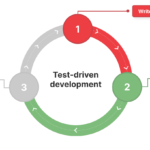Discover Why TDD Can Change the Productivity of an Organization

Bringing software to market is like going on a trip. You can always plan things out, but there are bound to be unforeseen circumstances that you will have to deal with.
Creating any software can be a months-long job, where contributors do their best to make the release a success. However, failures are inevitable – or is that what you thought?
Thanks to the TDD methodology, you can reduce the error rate before promoting software. It is a paradigm shift in the way of working that you need to know if you want to avoid those failed launches that can damage the image of an organization.
What is TDD and what is it for?
TDD stands for Test-Driven Development. This is a development model that is useful for all software organizations. Thus, the TDD methodology consists of a change in the work methodology. First, the tests are written, and then the source code that passes the test successfully is written.
Only then is the written code refactored, as this is the last stage of the process. Since the tests are performed initially, the number of errors is minimized. The result? A much more reliable, secure, and advanced system.
TDD is based on different principles. The most common ones are:
- Single Responsibility Principle (SRP). Modules will only have a single responsibility. In this way, the code becomes much simpler.
- Open/Closed Principle (OCP). When entities are dependent on each other, changes in one part could cascade to the others.
- Interface Segregation Principle (ISP). It states that interfaces should not be forced to depend on other interfaces that they do not need to use.
- Dependency Inversion Principle (DIP). A module A must not depend on module B but an abstraction of B.
What are the stages of TDD?

Next, we will tell you what the main stages of the TDD process in an organization are. This process will teach you to understand the best practices for the methodology.
-
Develop a test
First, you need to create a validation test. You need to know what the requirements and conditionals are. With this phase, you can avoid setting complex objectives that cannot be met. In the same way, you will also be able to create value from technology.
-
Write the code
This is the moment which, effectively, the service is generated. The development process has to focus on validating the test acceptance cases. If there is no code, the tests will be negative.
-
Validate the evidence
You’ve created the code. Now, you need to validate the tests you had previously set up. This step is the most important, as it will determine if it can meet the requirements.
This way, you avoid some problems related to lack of planning and the mistakes of failed launches.
-
Refactoring
Although the code is written, it does not mean that it is optimized. Therefore, you have to work it optimally through refactoring.
It is important to consider scalability. As the software grows, there will be new needs. This part of the process will frequently occur every few cycles. This moment is what will ensure that the process is secure over time.
The importance of applying TDD correctly

In any case, TDD allows for organized, agile, and secure software development. However, it can be complex to carry out since it will involve more work time.
However, it is essential to incorporate these TDD practices, but always with a context. Remember: this is simply a methodology, so you must know the context and purpose of the code you will develop. If there is no good business model, you can apply TDD, but the launch will not be successful.
Of course, the goal is for you to create the code. But, that’s not all: you should also implement the necessary tests to ensure good performance. In this way, you will start to observe the patterns of code implementation. The important thing is that every process is always designed to meet the customer’s needs.
Benefits of TDD
If you do it right, you’ll notice:
- Correct functioning of the code. You will reduce the chances of failures in the first weeks of launch. You will be able to test all the variables constantly. It may take more time, but the result will be very satisfactory.
- Improve code design. By thinking about everything in structures, you will start from the smallest to the most advanced. That is, the process is divided into distinct stages. Therefore, before possible scalability, you will not have problems adapting.
- Reduce time and resources. It may sound paradoxical since, by doing so many tests, you increase the development time. However, it is also true that you save time and resources. By testing, you don’t write code that you’re not going to use. In a way, you’re also saving time.
Undoubtedly, you already know that TDD can be an incredible option for all those organizations that seek successful software development.
If you like this type of article, keep reading our blog!


Leave a Reply
You must be logged in to post a comment.